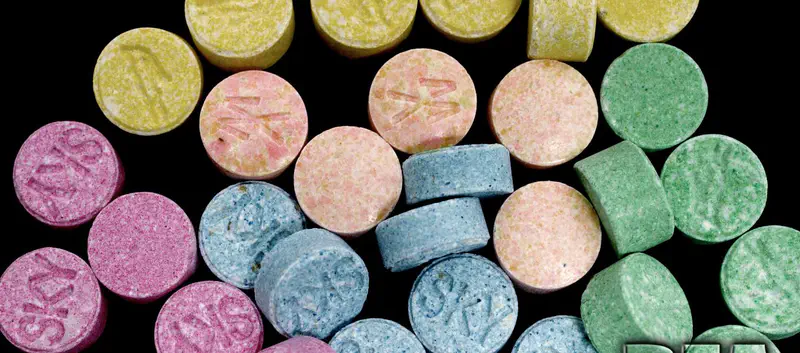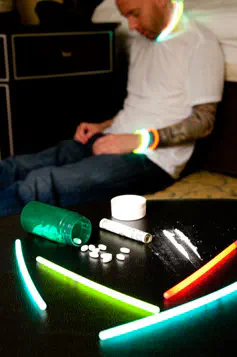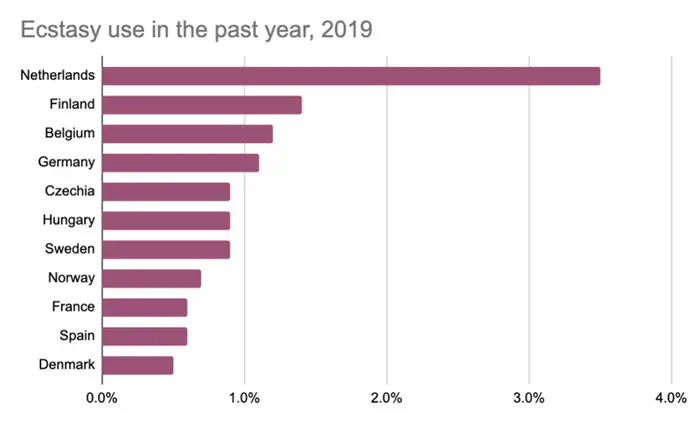DRUGS: WHAT YOU
NEED TO KNOW Booklet

Signs and Symptoms of MDMA/Ecstasy Use

Courtesy of DEA.gov
The drug referred to as MDMA and nicknamed ecstasy is a strong stimulant that is often used in nightclubs and other dance venues.1 Chemically, it is similar to methamphetamine, another strong stimulant, and it has certain hallucinogenic characteristics. A crystalline form of this drug is referred to as Molly. Its whole chemical name is 3,4-methylenedioxymethamphetamine.
Some people refer to the drug as an “empathogen,” in other words, it is said to create a false sense of empathy between the user and other people.2 It is usually consumed as a small coloured pill, often with some lettering or images embossed on it.
One danger of the drug is that often what is being sold as MDMA contains other even more dangerous substances. So the user actually doesn’t know what he or she is consuming.
Studies of this drug have found it could contain any of the following drugs and little or no MDMA:
- MDA (an MDMA-like drug)
- MBDB (butylene)
- Piperazines3
- Cathinones
- Ketamine4
- Phenethylamines
Effects of MDMA
The short-term effects of these drugs include the following: 5
- Artificially increased energy and stamina
- Increased sense of pleasure
- The illusion of emotional warmth
- Distortions of the senses of sight, touch and sound
- Altered time perception

A person who has taken ecstasy may be able to dance all night while feeling close to a person they just met. Dance venues take advantage of the fact that many patrons will be under the influence of this drug. They add elaborate light shows to the venue and hand out bracelets, necklaces and short sticks that light up to further stimulate their audience members. Furniture or even walls in the venue may be covered with a soft, suede-like fabric or some similar surface to excite the sense of touch.
MDMA has some severe and unpleasant side effects as well: 6
- Increased body temperature
- Increased heart rate and blood pressure
- Anxiety
- Cardiac arrhythmias
- Kidney failure
- Seizures
- Intracranial haemorrhage
- Nausea5
- Muscle cramping
- Involuntary teeth clenching
- Sweating
It is not unusual for users to develop sore jaws because of the constant and involuntary clenching of their teeth. They may carry around baby’s pacifiers in their mouths to prevent sore jaw muscles.
Also, because of the hyperthermic effect of this drug, some partiers who dance all night and don’t take time to drink water or cool off could suffer organ breakdown and death. A report from Germany described a 37-year-old woman who died from the effects of hyperthermia after consuming multiple doses of MDMA.7 Three hours after her death, her temperature was 41.7 degrees Celsius.
Dance venues may offer “chill rooms” and cold water to their patrons in an attempt to avoid these fatal outcomes.
After a person has been using this drug repeatedly, they are likely to notice symptoms like these: 5
- Irritability
- Aggression
- Depression
- Trouble sleeping
- Anxiety
- Memory problems
- Difficulty concentrating
- Reduced appetite
- Reduced interest in and pleasure from sex
Weekend Use May Become Habitual

If a person begins to use this drug when they go partying every weekend, this may set them up for a pattern in which they hit these severe adverse symptoms by midweek as they fully come down off their weekend doses of ecstasy. Some people may start taking more ecstasy mid-week to try to lift them out of their depression. Because it is a stimulant, it could lift them out of it, but midweek use starts a user on the path to habitual use.
Few people consuming ecstasy use only this drug—instead, most are polydrug users, meaning they take more than one drug at once.1 They may add ecstasy to their mix of drugs as they come down from methamphetamine, cocaine or heroin. Or they may be trying to enhance a high from alcohol, cocaine or heroin. Some people also use other drugs to soften the effect of coming down off ecstasy.
While few people enter drug treatment specifically for MDMA addiction, this could be due to the common pattern of polydrug use among those consuming this drug.8
A 2016 report also noted that ecstasy use was migrating from dance clubs and raves to general recreational use by young people across the EU.9 This trend was confirmed by wastewater analysis in 42 European cities in 2018 and 2019.10 Twenty-three of these cities showed an increase in ecstasy residues in wastewater. The highest levels of residues were found in Belgium, Germany and the Netherlands.
While the historical pattern has been that ecstasy pills were often adulterated with other drugs, in the last few years, the potency of ecstasy pills has been increasing significantly.3
Where Does the Ecstasy Come From?
In March of 2020, an anti-drug unit reported that more than 100,000 ecstasy pills had been smuggled out of Europe over the prior six months.11 This report noted that seizures of this drug had occurred in Germany, Portugal, France, the Netherlands, Belgium and Slovenia. Thirty thousand of these pills were reported to have been manufactured in Germany.12
Previously, MDMA manufacture had been centred in the Netherlands and Belgium.9
Who is Using Ecstasy?
Across Europe, an estimated 2.6 million people use ecstasy each year, with 13.7 million having used it at some point in their lives.13 Nearly 2% of young people (aged 15 to 34) use the drug each year.
This chart shows the European countries with the highest rates of use: 14

Courtesy of statista.com
For a partygoer seeking an enhanced experience, MDMA may seem like a good investment. Given its serious effects, even on first use, and the distinct possibility that use could become habitual, too many people are finding out that it is a very poor purchase.
Sources:
-
European Monitoring Centre for Drugs and Drug Addiction (2019), “Statistical Bulletin 2019 — prevalence of drug use”. EMCDDA Article ↩︎ ↩︎
-
Gillinder Bedi, et al.; US National Library of Medicine National Institutes of Health—PMC (2010) “Is ecstasy an ‘empathogen’? Effects of MDMA on prosocial feelings and identification of emotional states in others”. ↩︎
-
European Monitoring Centre for Drugs and Drug Addiction (2016), “Recent changes in Europe’s MDMA/ecstasy market—Results from an EMCDDA trendspotter study—April 2016”. EMCDDA Results from Study ↩︎ ↩︎
-
United Nations Office on Drugs and Crime (2013), “Patterns and Trends of Amphetamine-Type Stimulants and Other Drugs: Challenges for Asia and the Pacific”. UNODC Article (PDF) ↩︎
-
National Institute on Drug Abuse; National Institutes of Health; U.S. Department of Health and Human Services, “What is MDMA?” NIH Article ↩︎ ↩︎ ↩︎
-
Thomas J. Connor; US National Library of Medicine National Institutes of Health—PMC (2004), “Methylenedioxymethamphetamine (MDMA, ‘Ecstasy’): a stressor on the immune system”. PMC Article ↩︎
-
Juliane Lang, et al.; Romanian Society of Legal Medicine (2016), “Fatal Ecstasy-induced malignant hyperthermia with rhabdomyolysis. A case report”. Ecstasy Case Report ↩︎
-
European Monitoring Centre for Drugs and Drug Addiction (2019), “”European Drug Report Trends and Developments”. EMCDDA Drug Report ↩︎
-
Alex Bugge; Reuters—Healthcare & Pharma (2016), “Ecstasy use jumps in Europe, no longer just a dance drug: report”. Reuters report ↩︎ ↩︎
-
European Monitoring Centre for Drugs and Drug Addiction (2020), “New study on wastewater analysis shines light on city drug use—Latest wastewater data reveal drug-taking habits in 68 European cities — traces of stimulant drugs rise again”. EMCDDA Article ↩︎
-
Bangkok Post (2020), “Cops seize ecstasy pills smuggled from Europe”. Bangkok Post News Article ↩︎
-
Bangkok Post (2020), “Europe becoming the new source of ecstasy pills”. Bangkok Post News Article ↩︎
-
European Monitoring Centre for Drugs and Drug Addiction (2019), “Statistical Bulletin 2019 — prevalence of drug use”. EMCDDA Article ↩︎
-
Statista.com (2020), “Prevalence of ecstasy use in the last year in Europe as of 2019, by country”. Statista.com Chart ↩︎

 ®
®
